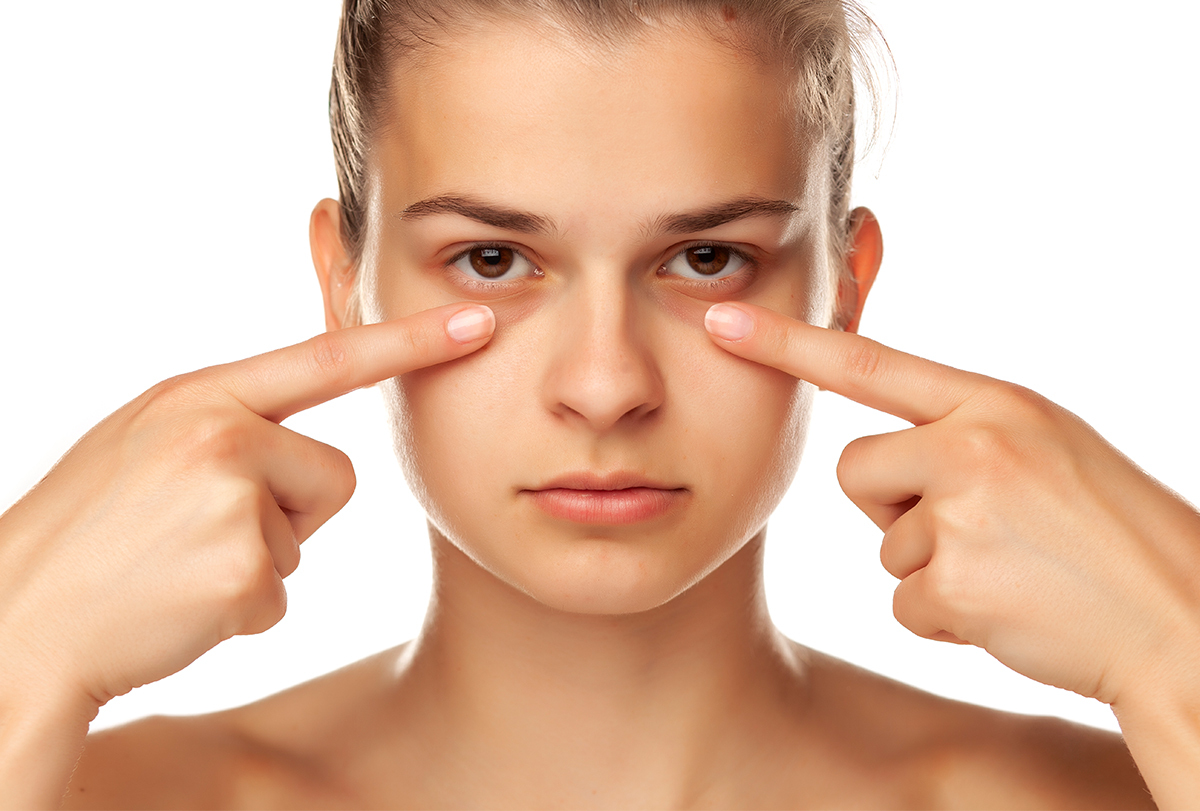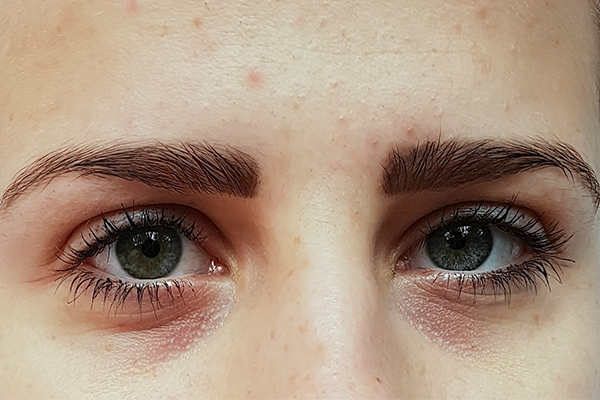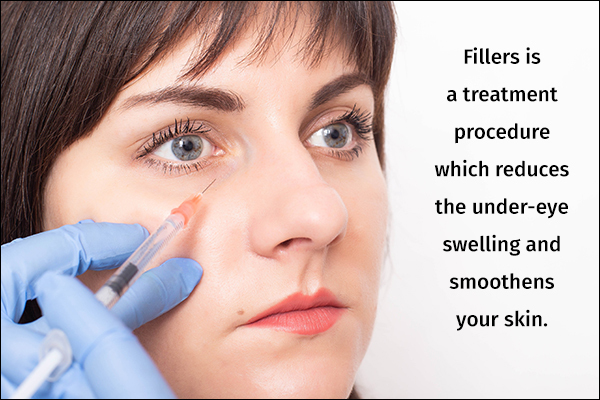In this article:
Under-eye bags can occur when weak or saggy skin forms pouches under the eyes. (1) Although eye puffiness may occur due to many reasons, treatment is usually simple.

In several cases, addressing the underlying cause may cure under eye bags completely.
Characteristics of Under-Eye Bags
Under-eye bags generally point towards fluid or fat buildup in the area triggered by any of the causes mentioned previously. Under-eye bags are characterized by the following:

- Dark circles under the eyes
- Mild or light swelling
- Saggy skin (2)
Causes of Under-Eye Bags
Many people develop swelling under the eyes in the morning. This is due to the absorption of tears while you sleep. Fluid retention around the eye tissues leads to swelling.
As we grow older, tissues around the eye gradually weaken and sag. This loss of skin and muscle tone allows fat to shift forward into the lower eyelids, making them look puffy and swollen.
Fluid can also pool in this area and lead to edema (swelling), which can contribute to the puffy appearance. (3) Poor lymphatic drainage and venous pooling contribute to fluid accumulation. (4)
Several factors can cause this condition, including:
- Heredity
- Allergies
- Crying
- Excess consumption of salt
- Dehydration (5)
- Smoking
- Stress
- Smoking
- Sinusitis
- Insomnia
- Thyroid disorders and other medical conditions such as kidney disorders
- A rare medical condition known as orbital fat prolapse, in which the adipose tissue protrudes under the conjunctiva of the eye (6)
The severity of eye puffiness may depend on the underlying cause. Hereditary eye bags tend to be chronic and difficult to get rid of.
Treatment for Under-Eye Bags
If you’re fed up with your under-eye bags, seek the following medical treatments, which can improve and even eliminate them:
a. Nonsurgical options
There are treatments, some involving slightly invasive procedures, that may help smoothen out the under-eye area. These treatments include:
1. Fillers

A filler material, such as hyaluronic acid, is injected between the under eye area and cheek area. It reduces the under-eye swelling and smoothens your skin. It may also cure dark circles. (7)
This procedure is performed under topical anesthesia or an anesthesia cream and can last up to a year.
2. Nonablative resurfacing laser
A laser is used to create heat under the surface of the skin, which indirectly increases collagen production. This method tightens the skin and reduces the appearance of wrinkles, saggy skin, and eye bags. (7) This procedure is usually performed in multiple sessions.
3. Chemical peel
A chemical peel can help fade the hyperpigmentation associated with under-eye bags by removing the damaged skin cells accumulated in the area. Since the skin around your eyes is very thin and sensitive, this procedure is best performed by a specialist. (7)
In this procedure, a chemical solution is applied to the under-eye area that dissolves the old, damaged cells accumulated on the skin surface. (7) As a result, the topmost skin layer peels off to reveal fresh skin underneath.
This newly formed skin that rises to the surface is tighter and brighter, thereby minimizing the appearance of the under-eye bags. Results may last up to a few years.
4. Allergy medicine
Allergies can also cause puffy eyes. Redness and itching in the eyes are common characteristics of an allergic reaction. Excess rubbing of the eyes and irritation may lead to swelling or puffiness in these cases.
Thus, taking allergy medicine will solve the under-eye bags caused by allergies.
5. Microneedling
Microneedling is the process of inserting tiny sterilized needles into the skin to puncture the deeper layer of skin and boost collagen production. It is performed by dermatologists to solve a number of skin issues, including wrinkles, eye bags, and acne scars. (8)
6. RF tightening
Radiofrequency eye tightening is a nonsurgical procedure that uses radiofrequencies to increase collagen in the skin. This helps in tightening the skin around the eyes, thereby reducing the puffiness. (7)(9)
7. PRP treatment
Platelet-rich plasma therapy is another procedure that helps reduce under-eye bags.
In this process, a blood sample is collected from the patient and separated into its various components. Collagen collected from this sample is then injected into the under-eye area to help tighten the skin. (10) The effects of this treatment can last up to a year.
b. Surgical options
Under-eye bags are mostly a cosmetic concern rather than a medical one, so you can do without invasive procedures such as surgery. However, if your under-eye bags are bothering you too much, one outpatient surgery can get the job done: blepharoplasty.
Blepharoplasty
Blepharoplasty (7)(11) is an eyelid surgery that may help get rid of under-eye bags. In this procedure, excess fat that has accumulated under the eyes is drained out by a surgeon via incisions made on the upper or lower eyelid.
Some complications that may arise during or after blepharoplasty are:
- Infections
- Swelling and bleeding
- Loss of vision
- Adverse reaction to anesthesia (11)
Diagnosing the Cause of Under-Eye Bags
To diagnose the cause behind your eye bags, the doctor will first examine them closely and inquire about your medical history. If the findings don’t clear up the picture, the doctor will order a few blood tests to rule out infections, thyroid diseases, endocrine disorders, and other conditions.
Your doctor may refer you to an ophthalmologist for further examination if you are also experiencing the following symptoms:
- Pain in or around the eye area
- Itching and irritation
- Redness in the eyes
- Extreme swelling
When to See a Doctor

Bags under the eyes may be unsightly, but they are usually harmless and do not require medical attention. However, if the swelling in your lower eyelid is accompanied by redness and irritation, it’s best to get it checked by a doctor to rule out any serious issue.
Final Word
Although under-eye bags may be cosmetically displeasing, they are not typically a sign of serious illness. In this case, prevention is better than cure, so avoid getting them in the first place. Getting adequate sleep, managing your allergies, and keeping yourself hydrated may help prevent eye puffiness.
If your under-eye bags do not improve with proper care or they last longer than a few weeks, they could be a symptom of an underlying health issue and may require a medical evaluation by a dermatologist.

- Was this article helpful?
- YES, THANKS!NOT REALLY


